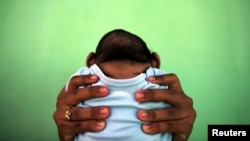Researchers have discovered the strongest evidence yet linking the Zika virus to the paralytic illness Guillain-Barre syndrome. During the height of the viral epidemic the incidence of Guillain-Barre was 100 times the number of cases usually seen.
Guillain-Barre is a normally rare condition that affects the peripheral nervous system, the nerves in arms and legs that are responsible for sensation and movement. The immune system attacks the fatty myelin coating of the nerves that protect and speed signals from the brain to the limbs.
Zika is in a family of viruses transmitted by mosquitoes called flavivirus, including dengue fever, yellow fever, Japanese encephalitis and chikungunya.
Normally, there are between one and two cases of Guillian-Barre per hundred thousand adults according to Carlos Pardo, a neurologist and pathologist at Johns Hopkins University in Maryland and lead author of a study published this week in the New England Journal of Medicine.
But at the height of the Zika epidemic between January and June in Colombia, where the study was conducted, hospitals were seeing 10 to 15 cases per week.
Pardo and colleagues from six institutions in the U.S., Central and South America established the first biological evidence connecting Zika to Guillain-Barre.
Investigators recruited 68 patients but because of research limitations were only able to look for evidence of Zika in 42 patients complaining of symptoms of Guillain-Barre syndrome. They underwent a genetics test looking for Zika RNA.
Seventeen - or 40 percent - of patients showed the virus’ genetic footprint.
Pardo’s team also conducted blood and urine tests on each patient. Investigators were able to culture the virus in the urine and found immune system-produced antibodies against Zika in the blood samples. The most positive results were in the urine.
Underreported
Occurrence of the disease was reported less in the media than microcephaly, another condition that linked to Zika. Microcephaly causes an abnormally small head and brain in newborns of mothers infected with Zika, leaving babies severely disabled.
Pardo says the magnitude of Guillain-Barre was similar to microcephaly.
Pardo says symptoms of Guillain-Barre syndrome typically appeared two to six weeks after people showed signs of infection with Zika, including fever, rash, headache and an eye infection called conjunctivitis.
Pardo says it’s important to get to patients early because there are treatments that can lessen the severity of Guillain-Barre.
“If we are able to diagnose those patients in an early stage, we are able to provide them with an early treatment… that may prevent those neurological disabilities,” said Pardo.
For now, the Zika epidemic has settled down with the rainy season.
But Pardo is worried what will happen when the weather in the Americas gets warmer and drier at the end of the year.
“Subsequently, there’s going to be a higher risk for Guillian-Barre and obviously maternal infection and higher risk for pregnant mothers to have babies with microcephaly,” said Pardo.
Treatment involves filtering the blood to clean up the immunological factors that attack the peripheral nervous system, causing Guillain-Barre syndrome.









